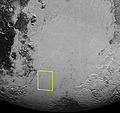File:Pluto-puzzling-pits-2.png

Original file (852 × 1,266 pixels, file size: 1.37 MB, MIME type: image/png)
Captions
Captions
Summary
[edit]| DescriptionPluto-puzzling-pits-2.png |
English: UPLOADER NOTES: This image was taken by the Long Range Reconnaissance Imager (LORRI) on NASA's New Horizons spacecraft shortly before closest approach to Pluto on July 14, 2015; it resolves details as small as 270 yards (250 meters). The scene shown is about 130 miles (210 kilometers) across. The sun illuminates the scene from the upper left, and north is to the upper right.
The original NASA image has been flipped vertically to correct the image presentation and rotated 90 deg. clockwise to put north at the upper right. The original NASA caption is as follows: It seems that the more we see of Pluto, the more fascinating it gets. With its prominent heart-shaped feature, icy mountains, and “snakeskin” terrain, Pluto has already surprised New Horizons scientists with the variety and complexity of its surface features. Now this latest image, from the heart of Pluto’s heart feature, show the plains’ enigmatic cellular pattern (at left) as well as unusual clusters of small pits and troughs (from lower left to upper right). Scientists believe that this area, informally known as Sputnik Planum, is composed of volatile ices such as solid nitrogen. They theorize that the pits and troughs – typically hundreds of meters across and tens of meters deep – are possibly formed by sublimation or evaporation of these ices. However, the reasons for the striking shapes and alignments of these features are a mystery. Adding to the intrigue is that even at this resolution, no impact craters are seen, testifying to the extreme geologic youth of Sputnik Planum. “Pluto is weird, in a good way,” said Hal Weaver, New Horizons project scientist with Johns Hopkins Applied Physics Laboratory in Laurel, Maryland. “The pits, and the way they’re aligned, provide clues about the ice flow and the exchange of volatiles between the surface and atmosphere, and the science team is working hard to understand what physical processes are at play here.” |
| Date | |
| Source | https://www.nasa.gov/nh/pluto-puzzling-patterns-and-pits |
| Author | NASA / Johns Hopkins University Applied Physics Laboratory / Southwest Research Institute |
| Other versions |
|
Licensing
[edit]| Public domainPublic domainfalsefalse |
| This file is in the public domain in the United States because it was solely created by NASA. NASA copyright policy states that "NASA material is not protected by copyright unless noted". (See Template:PD-USGov, NASA copyright policy page or JPL Image Use Policy.) |  | |
 |
Warnings:
|
File history
Click on a date/time to view the file as it appeared at that time.
| Date/Time | Thumbnail | Dimensions | User | Comment | |
|---|---|---|---|---|---|
| current | 20:33, 25 October 2015 |  | 852 × 1,266 (1.37 MB) | WolfmanSF (talk | contribs) | Flip vertically to correct for incorrect image presentation and rotate 90 deg. clockwise to put north to the upper right |
| 08:54, 25 October 2015 |  | 1,266 × 852 (1.36 MB) | WolfmanSF (talk | contribs) | Higher resolution version | |
| 10:45, 22 October 2015 |  | 985 × 663 (771 KB) | Mas003 (talk | contribs) | {{Information |Description ={{en|1=This image was taken by the Long Range Reconnaissance Imager (LORRI) on NASA's New Horizons spacecraft shortly before closest approach to Pluto on July 14, 2015; it resolves details as small as 270 yards (250 meter... |
You cannot overwrite this file.
File usage on Commons
The following 4 pages use this file:
File usage on other wikis
The following other wikis use this file:
- Usage on ca.wikipedia.org
- Usage on en.wikipedia.org
- Usage on es.wikipedia.org
- Usage on fr.wikipedia.org
Metadata
This file contains additional information such as Exif metadata which may have been added by the digital camera, scanner, or software program used to create or digitize it. If the file has been modified from its original state, some details such as the timestamp may not fully reflect those of the original file. The timestamp is only as accurate as the clock in the camera, and it may be completely wrong.
| Image height | 852 px |
|---|---|
| Image width | 1,266 px |

